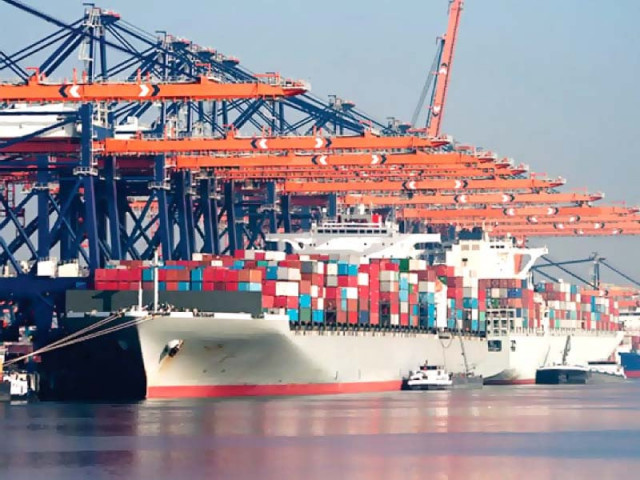Exports, remittances to stay lower
Inflows may remain $13.8b less than target; trade deficit narrows to $19.6b

Pakistan on Thursday informed the International Monetary Fund (IMF) that its non-debt creating inflows may remain around $13.8 billion less than the budgetary estimates in the current fiscal year, which would be partially offset by lower imports.
The government shared its fresh estimates of inflows and outflows on account of exports, remittances and imports with the IMF the day Pakistan Bureau of Statistics (PBS) released its trade summary for the July-January period of current fiscal year, ie 2022-23.
According to the PBS data, Pakistan’s trade deficit narrowed nearly one-third and reached $19.6 billion in the first seven months of FY23 due to restrictions on imports while exports fell 7.2%. The government also told the IMF that exports would remain significantly lower than the earlier estimates.
The revised macroeconomic projections did not show a rosy picture of exports and remittances. But both imports and current account deficit are expected to remain on a declining path.
As against the budgetary estimate of $33.5 billion, the government told the Fund that workers’ remittances could remain around $29.5 billion, with a shortfall of $4 billion. Similarly, exports could remain in the range of $28 billion to $29 billion, a reduction of $8.8 billion to $9.8 billion from the annual target, it added.
The cumulative reduction in both non-debt creating inflows was $13.8 billion compared with the budgetary figures published in the Annual Plan 2022-23.
The development also came the day the central bank announced that its gross official foreign exchange reserves further depleted to a 10-year low of $3.1 billion due to external debt repayments.
From July through January of FY23, the gap between imports and exports came in at $19.6 billion, down by $9.3 billion, or 32%, compared to the same period of last year, the PBS reported.
The worrisome aspect was the dip in exports as import reduction could be a temporary phenomenon, caused by the administrative restrictions imposed by the central bank and the federal government.
PBS data showed that exports stood at $16.5 billion, down by $1.3 billion, or 7.2%, during the July-January period. As a result, the annual export target of nearly $38 billion has become irrelevant owing to the poor performance, which the government also admitted before the IMF.
Sources said that Pakistan told the Fund that exports could dip to $28-29 billion, a reduction of $8.8-9.8 billion against the annual target. This requires some introspection and the immediate discontinuation of export subsidies. The IMF has already demanded the withdrawal of unbudgeted electricity subsidies for exporters. During the last fiscal year, Pakistan had exported goods worth $32.5 billion.
Imports in July-January FY23 amounted to $36.1 billion, down by $10.5 billion, or 22.5% year-on-year, the PBS report stated.
However, the reduction came in the wake of administrative controls, which forced banks not to clear letters of credit and created other administrative hurdles.
As a consequence, about 9,000 containers were stuck at ports because of the shortage of dollars. After the government let the rupee devalue last Thursday, its import revenues have jumped significantly.
The government told the IMF that as against the annual estimate of $65.5 billion, imports may remain around $55.5 billion to $57.5 billion. The new estimate is about $8 billion less than the previous forecast, which will offset the impact of $13.5 billion reduction in the non-debt creating inflows.
Former finance minister Miftah Ismail said that Pakistan sustained losses of $3 billion in exports and remittances in the wake of the artificial exchange rate maintained by the central bank for four months.
During the last fiscal year, the country imported goods worth $72 billion, contributing to a $17.4 billion current account deficit.
However, the IMF was informed on Thursday that the current account deficit may remain around $8 billion in the current fiscal year, which was significantly lower than the previous forecast and would ease pressure on the external sector.
Last month, the SBP ended its administrative controls but has not eased its informal control over banks aimed at keeping imports under check.
PBS stated that on a year-on-year basis, exports showed 15.4% contraction in January and stood at $2.2 billion against $2.6 billion in the same month of previous year. In absolute terms, there was a dip of $403 million in exports.
Imports were lower by $1.2 billion, or nearly 20%, in January, compared with the same month a year ago. Trade deficit narrowed by 23% to $2.7 billion in January, showing a reduction of $777 million.
On a monthly basis, exports decreased by 4.4% while imports fell by 5.8%.
Published in The Express Tribune, February 3rd, 2023.
Like Business on Facebook, follow @TribuneBiz on Twitter to stay informed and join in the conversation.

















COMMENTS
Comments are moderated and generally will be posted if they are on-topic and not abusive.
For more information, please see our Comments FAQ